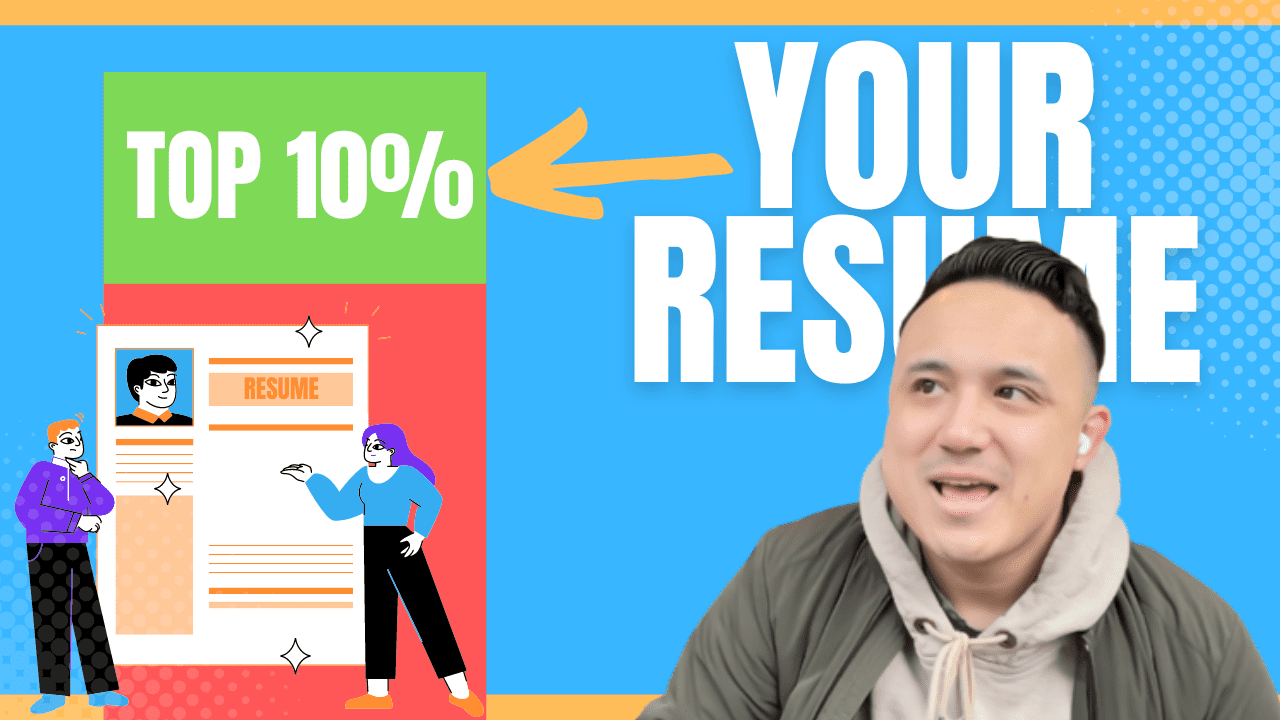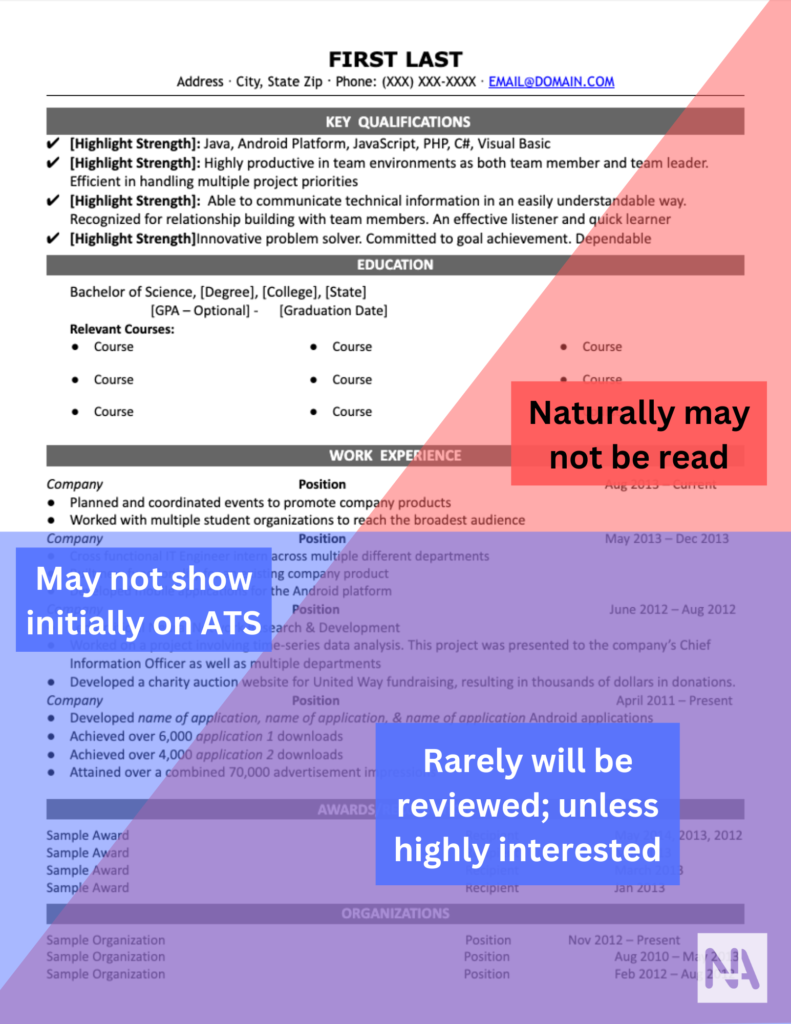Top 3 Tips When Making Your Resume to Put Yourself 90% Ahead of Everyone Else

Update: This article has been revised and updated. You can read the newest article here, “Top 3 Tips For Making a Great Resume.”
Over the past 10 years, I’ve probably reviewed 1000’s of resumes.
Whether it was during my time facilitating workshops for college student organizations or reviewing resumes for roles that I was looking to hire for…
…there were three things that people were missing over and over again.
So if you are making your resume for the first time, or updating it to make your next career move –
I wanted to put together my top 3 tips when making your resume to put yourself 90% ahead of everyone else.
During this article there will be three main focus areas:
- Style. There are a lot of resume templates, but I’ve found there to be similarities in the best ones that I’ve seen.
- Formatting. The experience you include on your resume is there for a reason. You’ve accomplished great things – we want to make sure recruiters see that!
- Numbers & Metrics. Being a sales associate is too general. Being a sales associate at a retail store that sells $1.3 million a year is very different than an associate that is working at a middle-of-the-mall kiosk stand that sells $50,000 a year.
Select a resume-style template that is easy to read
Far too often, I see resumes that have highlights everywhere and too many unnecessary things bolded or italicized.
When you are using these in your resume, you want to use them only to really draw the recruiter’s eye to what matters.
If you use them too much throughout your resume, the information will start to blend in with everything else.
List your most impressive accomplishments first
Before we select a template it’s important to note that not all of the page is treated equally.
In most cases, less than half of the page will receive most of anyone’s attention.
But wait, my resume is more than one page!?!?
❌ Do not make your resume more than one page
There are some rare, and I mean rare scenarios where this might be acceptable – but broadly speaking, avoid more than one page.
And don’t think you’re sneaky by making the font smaller than 12 pt and reducing the side margins to less than 0.25″. Don’t do that.
In the diagram below, there are two points to consider when you are selecting a template and starting to populate with your experiences.

People will naturally start to skim your resume (Zone: Red)
Towards to top of a resume, people may read through an entire line from left to right across the paper.
As they start to progress down your page, they will start to read less and less.
Don’t believe me?
Try it yourself.
Pick up a book and start to skim through the page.
You’ll notice that as you start to go further down the page, you’ll start to look for only keywords rather than read each and every word.
Recruiters will skim your resume in the same way.
Not all of your resume will show up at once for a recruiter (Zone: Blue)
When you apply for a job online – you will need to populate a ton of details, sometimes repeating the information that is already on your resume, for the recruiters to review.
Depending on the system the recruiter is using – known in the industry as an Applicant Tracking System (“ATS”) – when your resume shows on their screen – it’s only going to show a portion of it.
If you do not capture the recruiters’ attention in those first few seconds, they will not scroll to read more.
What that means is that you need to prioritize the information towards to top to really have some of your best work to capture their attention.
❌ Remove the picture of yourself
❌ Remove the objective – they know what role you’re applying to already
✅ List the most relevant information that the Recruiter is looking for
Now identifying the most important information is going to depend on the role you are applying to.
If it’s an entry-level role, they are going to be interested that you may have graduated with a degree they are searching for – so put that towards the top.
If it’s a more senior role, you will want to highlight your relevant experience and move your education sections toward the bottom.
The job posting will provide tips for what they are specifically looking for. Use the job posting to help you determine what’s most important to them!
Selecting a Resume Template
There are a lot of places to start when you are looking for resume templates.
Having something that “looks pretty” is great, but if you look back at the section that we just reviewed on the most valuable areas of your resume…
…you’ll notice that those templates are completely wasting that space.
Here are some samples from Indeed that you can view and evaluate yourself.
So where can I find templates to use?
I remember when I was first starting out, I had no idea where to get started.
My first attempt was going to the SJSU Career Center.
There were some resources and guidance available…
…but they still required some work on my end.
Here are the templates that I’ve used over the years in the different phases of my career.
Everyone at the end of the day will have their own preference, but so far – these have worked well for me.
Activity: “The 3-second Resume”
Do you really want to know if your resume is getting across the core information you want?
Try this activity. If you can find a stranger – it’s even better!
Note: You’ll need something to keep the time, like the stop clock on your phone.
- Print a couple of copies of your resume.
- Hand someone a pen and your resume face-down.
- Provide them the following instructions: “When I say go, please review the resume and try to gather as much information as you can within 3 seconds. When I tell you time is up, flip the resume to its blank side and start to write down anything you can remember.”
- Allow them to fill out the blank side of the resume for 10-15 seconds.
- Review what was written down.
You may be surprised what details really stood out in your resume.
Try this a few times with different people. The less they know about you, the better as it will simulate what a recruiter will take away.
Format your experience to highlight your IMPACT
After you’ve selected the template you want to use, it’s time to start filling it out!
One of the most important sections, if not THE most important section, are the bullets within each past and the current job you list.
If you are using one of the resume templates that I provided, you’ll see that some of them have this formula within each job description:
Job Experience Layout: [Power Word] [Impact] [How you made that Impact]
Let’s break down each of these three parts so that you can be a MASTER at completing your resume.
Power Words
Sometimes also known as Action Verbs or Resume Words…
…the key thing to take away is to start each bullet with a verb to SHOW (not tell) the recruiter what you did in this role.
There are many sites that you can find through Google.
Here are two to help get you started: Novo Resume, The Muse
Impact
This is the part where you can start to show what you accomplished in this role.
Let’s use an example to help illustrate this.
We will use the example where we are a Sales Associate at a retail company.
So I’ll start with a Power Word, let’s go with “Increased”.
I’ll combine it with my impact on “sales”
If we put those together, the starting of this bullet would read: “Increased sales”
Well that is awfully short and lacks any details, so let’s go into the next section and add “how”
How you made that impact
If we want to provide context to how we made an impact in our role, this is where you can do it.
We have “Increased sales” so far, so now let’s add the “how.”
An example could be: “Increase sales by developing a sales onboarding handbook for all new hires”
Already you are starting to stand out from other sales associates that work in a retail environment…
…but let’s make it even better!
Include numbers and metrics to add perspective to your accomplishments
If I was reviewing a resume and saw the description that said “Increased sales by developing a sales onboarding handbook for all new hires,”
I would be asking myself a few questions:
- By how much did the sales increase by (either % or absolute number)
- Over what time duration did the sales increase by
- How many new hires were affected by this change
There are probably other questions you too could come up with, but let’s use those to help guide how we can incorporate numbers and metrics into our bullet point description.
👉 Increased sales by 20% in 6 months across 13 locations by developing a sales onboarding handbook that was used to train 27 new hires
We can probably continue to wordsmith that even more, but you’ve already jumped well above anyone else that may be putting together their resume.
But how do I find these numbers or metrics?
One of the first things that I do is ask my manager or other team members.
If they ask why – you can always say that it’s for your own knowledge to better understand the impact of your work.
Usually, the information is a lot more available than you might think.
Following these top 3 tips when making your resume will help you stand out from the crowd
Let’s quickly recap the main parts that we covered in this article:
- Style. With a better understanding of what part of your resume matters the most, you can better prioritize your information
- Formatting. Remember the job experience layout and you’ll be golden: [Power Word] [Impact] [How you made that Impact]
- Numbers & Metrics. After you write your bullet points, take a second and ask yourself questions. Adding numbers will take this: “Increased Sales,” to this “Increased sales by 20% in 6 months across 13 locations by developing a sales onboarding handbook that was used to train 27 new hires.”
Best of luck in your job search.
You got this!
